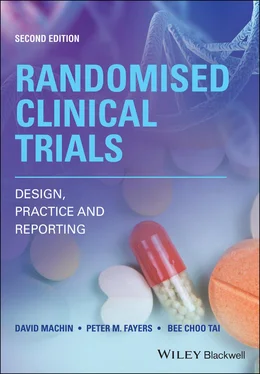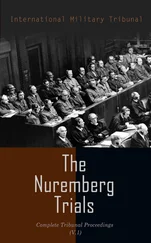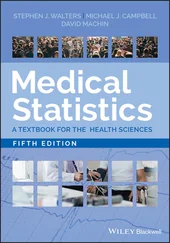Despite perhaps not having a professional interest in the science of clinical trials, everyone has a vested interest in them as potential patients requiring care. How many of us have never been to see a doctor, had a hospital admission or taken medication? All of us may be, have been, or certainly will be, recipients of clinical trial results whether during prebirth, at birth or in childhood for vaccination and minor illness, as an adult for fertility, sports injuries, minor and major non‐life‐threatening or life‐threatening illnesses, and in old age for care related to our mental or physical needs.
1.2 Some completed trials
As we have indicated, there are countless ongoing trials and many have been successfully conducted and reported. To give some indication of the range and diversity of application, we describe a selection of clinical trials that have been conducted. Their designs include some features that we also draw upon as examples in later chapters.
Example 1.1 Small parallel two‐group design – gastrointestinal function
Lobo, Bostock, Neal, et al . (2002) describe a randomised trial in which 20 patients with colonic cancer either received postoperative intravenous fluids in accordance with current hospital standard practice ( S ) or according to a restricted intake regimen ( R ). A primary endpoint measure in each patient was the solid‐phase gastric emptying time on the fourth postoperative day. The observed difference between the median emptying times was shorter with R by 56 minutes with 95% confidence interval (CI) from 12 to 132 minutes. The trial also included preoperative and postoperative (days 0, 1, 3 and 5) measures of the concentrations of serum albumin, haemoglobin and blood urea in a repeated measures design.
Key features include the following:
Design: Randomised comparison of a standard and test, single‐centre participation, unblinded assessment,
Endpoint: Gastric emptying time,
Size: 21 patients following colonic resection,
Analysis: Mann–Whitney U‐test 1 for comparing two medians,
Conclusion: The restricted intake group had shorter delays in returning to gastrointestinal function.
1 This can also be referred to as the Wilcoxon rank‐sum test.
Example 1.2 Parallel two‐group design – hepatitis B
Levie, Gjorup, Skinhøj and Stoffel (2002) compared a 2‐dose regimen of recombinant hepatitis B vaccine including the immune stimulant AS04 with the standard 3‐dose regimen of HbsAg in healthy adults. The rationale behind testing a 2‐dose regimen was that fewer injections would improve compliance.
Key features include the following:
Design: Two centres, open‐label randomised two‐group comparison,
Endpoint: Seroprotection rate,
Size: 340 healthy adults aged between 15 and 40 years,
Analysis: Fisher's exact test,
Conclusion: The 2‐dose regimen compared favourably with the standard.
Example 1.3 Unstructured three‐group design – newly diagnosed type 2 diabetes
The randomised trial of Weng, Li, Xu, et al . (2008) compared, in newly diagnosed patients with type 2 diabetes, three treatments: multiple daily insulin injections (MDI), continuous subcutaneous insulin infusion (CSII) and oral hypoglycaemic agent (OHA).
Key features include the following:
Design: Nine centres, randomised three‐group comparison,
Endpoint: Time of glycaemic remission,
Size: 410 newly diagnosed patients with type 2 diabetes,
Analysis: Cox proportional‐hazards regression model,
Conclusion: Early intensive therapy has favourable outcomes on recovery and maintenance of β‐cell function and protracted glycaemic remission compared to OHA.
Example 1.4 Small dose–response design – pain prevention following hand surgery
Stevinson, Devaraj, Fountain‐Barber, et al . (2003) conducted a randomised double‐blind, placebo‐controlled trial to compare placebo with homoeopathic arnica 6C and arnica 30C to determine the degree of pain prevention in patients with carpel tunnel syndrome undergoing elective surgery for their condition. Pain was assessed postoperatively with the short‐form McGill Pain Questionnaire (SF‐MPQ) at four days. A total of 64 patients were randomised to the three groups resulting in median scores of 16.0 (range 0–69), 10.5 (0–76) and 15.0 (0–82) for the respective groups. From these results, the authors suggest that homoeopathic arnica has no advantage over placebo in reducing levels of postoperative pain.
Key features include the following:
Design: Single‐centre, randomised double‐blind, placebo‐controlled, three‐group dose response,
Endpoint: Pain using the SF‐MPQ,
Size: 64 patients undergoing hand surgery for carpal tunnel syndrome,
Analysis: Kruskal–Wallis test,
Conclusion: Irrespective of dose homoeopathic arnica has no advantage over placebo.
Example 1.5 Large dose–response design – HER2‐positive breast cancer
Smith, Procter, Gelber, et al . (2007) showed that 1 year of treatment with Trastuzumab ( T ) after adjuvant therapy in HER2‐positive patients with breast cancer was superior to Observation ( O ) alone. They reported a hazard ratio, HR = 0.66 (95% CI 0.47 to 0.91, p ‐value = 0.0115) for overall survival in favour of adjuvant treatment. This comparison was from two arms of a three‐arm large multicentre international randomised trial comprising 1698 patients randomised to O , 1703 to T for 1 year ( T 1) and 1701 to T for 2 years ( T 2): a total of 5102 patients.
Key features include the following:
Design: Randomised, multicentre, observation versus active treatment,
Size: Part of a large trial of 5102 women with HER2‐positive breast cancer,
Endpoint: Overall survival,
Analysis: Comparison in 3404 women from the O and T1 groups using survival curves,
Conclusion: Treatment with T1 after adjuvant chemotherapy has a significant overall survival benefit.
Example 1.6 Non‐inferiority trial – uncomplicated falciparum malaria
Zongo, Dorsey, Rouamba, et al . (2007) conducted a randomised non‐inferiority trial to test the hypothesis that the risk of recurrent parasitaemia was not significantly worse with artemether–lumefantrine ( AL ) than with amodiaquine plus sulfadoxine–pyrimethamine ( AQ + SP ). A total of 826 patients were screened of which 548 were found to have uncomplicated malaria and were randomised (273 to AQ + SP and 275 to AL ). A primary endpoint was the risk of treatment failure within 28 days of randomisation. The authors concluded that AQ + SP , with a recurrent malaria rate of 1.7% (4/233), was more effective than AL , with a rate of 10.2% (25/245) and representing a difference of 8.5% (95% CI 4.3–12.6%). These results suggest that the hypothesis of ‘non‐inferiority’ should not be accepted as the CI included the non‐inferiority limit of 3% set by the investigators.
Key features include the following:
Design: Multicentre, two‐group, non‐inferiority trial,
Endpoint: Time to recurrent malaria,
Size: Large – 548 patients with uncomplicated falciparum malaria,
Analysis: Comparison of Kaplan–Meier survival curves,
Conclusion: AL was less effective than (inferior to) AQ + SP.
Example 1.7Repeated measures – atopic eczema
Meggitt, Gray and Reynolds (2006) randomised 63 patients with moderate‐to‐severe atopic eczema to receive either Azathioprine or Placebo in a double‐blind formulation to ascertain the relative reduction in disease activity determined by the six‐area six‐sign atopic dermatitis (SASSAD) score between the groups. One patient in each group subsequently withdrew from the trial before treatment was initiated. The investigators reported a 5.4 unit advantage with Azathioprine. In this trial, patients were randomised using a minimisation procedure, in the ratio of 2 to 1 in favour of Azathioprine in order to.
Читать дальше












